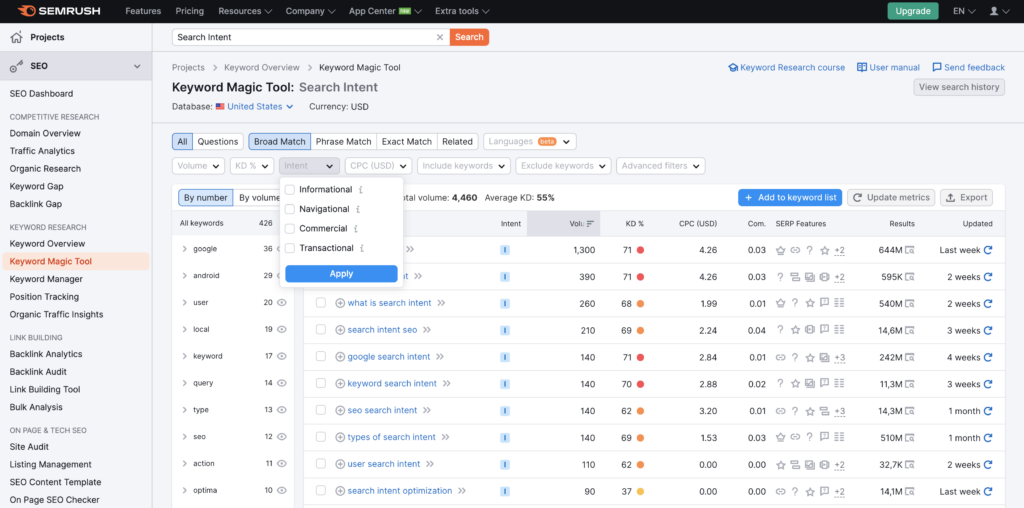
As search engines strive to deliver more accurate and personalized results to users, understanding the essence of user intent has become paramount in crafting successful SEO strategies.
Search intent, often referred to as “user intent,” is the fundamental motivation behind a user’s online search query. It delves into the question of “why” a user is searching for a particular keyword or phrase, and deciphering this SEO intent is instrumental in connecting them with the most relevant content.
Imagine you run an online pet store and want to optimize your website for the keyword “dog food.” Without comprehending search intent, you might inadvertently attract users looking for information on dog food recipes, those seeking the nearest pet store, or individuals researching the nutritional value of various dog food brands. By understanding search intent, you can optimize content for SEO to cater to the specific needs of your target audience, thereby increasing the likelihood of conversions and enhancing user satisfaction.
In this article, we will delve into the world of search intent in SEO, exploring its significance and the various types that exist. We will equip you with essential techniques to identify search intent for your target keywords, ensuring your SEO efforts hit the mark.
What is Intent in SEO?
To ensure that users find the most relevant and valuable results in search engine results pages (SERPs), search engines rely on machine learning models to understand the specific reasons behind a user’s search query. This understanding begins with Google’s effort to identify the SEO search intent of the entered query.
Google user intent refers to the objective that individuals have in mind when they enter a particular search phrase. Their objective might be to acquire information on a specific topic or find a solution to a problem. Some users may be seeking to make a purchase or take action on a website, while others prefer to research product information and make comparisons before making a decision.
Google’s primary aim is to present the most relevant answer to a search query at the top of the SERP. Consequently, most marketers strive to align their content with the Google search intent to significantly improve their rankings in search results.
Why is Search Intent Important for SEO?
User intent holds significant importance on Google’s priority list, and marketers who aim for success in SEO should prioritize it as well. SEO has evolved beyond simply selecting high-traffic keywords and inserting them into content.
Today, the focus is on providing information that aligns with user search intent. When your content matches user intent, Google’s ranking algorithm recognizes it and elevates your position in search engine results pages (SERPs). Keywords play a vital role in identifying this intent.
By comprehending the purpose behind online search queries, you can achieve the following:
- • Improve your keyword research strategy by emphasizing search queries that fulfill your audience’s needs while driving more targeted website traffic.
- • Create valuable, user-oriented content.
- • Boost your SERP rankings, leading to increased visibility, enhanced credibility, and improved domain authority.
Our SEO company will be happy to help you achieve your goals in this area.
What are the Common Types of Search Intent?
Understanding the different types of search intent is key to tailoring your content and SEO strategy effectively. Let’s see each type to gain a comprehensive understanding:
Navigational Intent
Navigational intent is all about users searching for a specific website, brand, or webpage. These users already have a destination in mind and use search engines as a convenient route to get there.
For example, someone looking for the official website of a popular clothing brand may search for “Nike website” rather than typing the URL directly.
Transactional Intent
Transactional intent is at its peak when users are ready to make a purchase or take a specific action online. These users have already done their research and are now seeking the best place to buy the product or service they desire.
Searches like “buy Samsung Galaxy S30” or “book flight to New York” exemplify transactional intent.
Commercial Intent
Commercial intent comes into play when users are researching products or services but haven’t made a final decision. They seek information to compare options, read reviews, and find the best deals.
Queries like “best smartphones 2023” or “top SEO companies” indicate commercial intent.
Also, commercial queries often contain words like “buy”, “purchase”, “service”, but unlike Transactional Intent, this is not a specific product, and the user is still in the selection process.
Informational Intent
Informational intent is driven by users seeking knowledge, answers to questions, or guidance on specific topics. They want informative content, how-to guides, tutorials, or solutions to their problems.
Queries such as “how to start a blog” or “benefits of intermittent fasting” fall under informational intent.
Local Intent
Local intent is prevalent when users are searching for products, services, or information specific to a particular location. These searches often include phrases like “near me” or mention a specific city or region. Examples include “restaurants near me” or “plumbers in Los Angeles.”
Understanding the nuances of each intent type is essential to align your content with what users are looking for. Adapting your SEO strategy to accommodate these different search intent types will help you attract the right audience and offer them precisely what they need.

7 Steps to Identify Your Keyword Search Intent
Deciphering search intent SEO behind your target keywords is crucial for creating content that resonates with your audience and aligning with their needs. Here are 7 steps to help you identify search intent effectively:
Step 1. Determine the Google SERP Top 10 content type
When you want to understand the search intent behind a specific keyword, the first step is to examine the content types that appear on the Google SERP’s top 10 results. Google typically displays a variety of content formats, and these formats can give you insights into what users are looking for when using that particular keyword.
Take note of the content types in the top 10 results, such as blog posts, product pages, videos, infographics, or guides. If the majority of the top results are blog posts or articles, it suggests that users are seeking in-depth information or answers to questions. On the other hand, if product pages dominate the SERP, it indicates a transactional search intent, where users are looking to make a purchase.
Understanding the content types present will help you tailor your content to match user expectations, increasing the likelihood of your page ranking higher in search results.
Step 2. Check the related searches
Once you have an idea of the content types that dominate the SERP, it’s time to explore the related searches at the bottom of the page. Google often provides these related search queries to offer users additional options closely related to their original search term.
By examining the related searches, you can identify common themes and patterns that indicate the broader search intent behind the keyword you are targeting. Look for recurring phrases or questions in the related searches to understand the user’s intentions better.
For example, if you are targeting the keyword “best digital cameras,” the related searches might include “mirrorless vs. DSLR cameras,” “top-rated camera brands,” or “camera buying guide.” These related searches reveal that users are not only looking for camera recommendations but also seeking comparisons and guidance before making a purchase decision.
Step 3. Analyze keyword modifiers
Keyword modifiers are words that users include with their primary keyword to refine their search. These modifiers can significantly influence the search intent behind a keyword. Analyzing these modifiers will help you understand what users want precisely when using that keyword.
For example, if your primary keyword is “healthy breakfast recipes,” various modifiers could change the intent significantly, such as “easy,” “quick,” “vegan,” or “for weight loss.” Each of these modifiers reflects a specific intent – users searching for quick recipes may be looking for convenience, while those searching for vegan options may want plant-based alternatives.
Identify the most common modifiers related to your target keyword and ensure your content addresses these specific intents to meet user needs effectively.
Step 4. Look for different forms of content (image/video packs)
The SERP offers valuable insights into user preferences for content types, including images and videos.
For instance, a search for “interior design for small bedroom” displays an image pack at the top, indicating that users seek visual inspiration for their small bedrooms. In this scenario, ranking with a descriptive guide or promoting services would be less effective. To cater to the search intent accurately, create an image-heavy blog post with a complementary video or prioritize ranking on platforms like Pinterest or YouTube.
Understanding the search intent empowers you to tailor your content strategy effectively, optimizing for visual solutions that resonate with users.
Step 5. Monitor on-site search queries
This step focuses on analyzing the search queries made within your website’s internal search feature. On-site search queries can offer valuable information about what your visitors are looking for after they arrive on your site.
By understanding the search intent of your on-site visitors, you can improve your website’s navigation, highlight relevant content, and create new materials to address their needs better. Keep a close eye on the frequently searched terms and tailor your content accordingly.
Step 6. Leverage user surveys and feedback
It involves gathering direct feedback from your audience through user surveys, feedback forms, or social media interactions. Engaging with your audience will provide valuable insights into their motivations and intentions when using specific types of keywords or searching for particular topics.
Ask open-ended questions to understand what users hope to achieve with their searches, what challenges they face, and what solutions they seek. This information can help you fine-tune your content and align it with user expectations more effectively.
Step 7. Analyze competitor content
Understanding how your competitors approach the same target keyword is a crucial step in refining your content strategy. By analyzing their content that ranks well, you gain valuable insights into what resonates with your shared audience and what drives their engagement.
Start by exploring the top-performing content pieces from your competitors that appear on the first page of search engine results. Take note of their content’s structure, formatting, and length to identify patterns that contribute to their success.
During your competitor keyword analysis, focus on how your competitors address the SEO user intent behind the focus keyword. Evaluate whether they provide direct and relevant answers to user queries, meeting the needs and expectations of their audience effectively.
By identifying how they fulfill the search intent, you can strategize to align your content with user expectations while adding a unique twist to stand out from the crowd.
How to Implement User Search Intent Into Your SEO Strategy
Understanding user search intent is one thing, but successfully implementing it into your SEO strategy is what sets the foundation for your online success. Here’s how you can do it:
Determine the keyword clusters
After identifying the search intent behind your target keywords, organize them into clusters based on their intent type. Group together keywords that share similar user intents. This will help you create more focused and relevant content that caters to the specific needs of your audience.
Create relevant content to meet user intent
Once you have your keyword clusters, start crafting content that aligns with each intent type. Develop blog posts, product pages, guides, or other content formats that directly address the user’s queries and provide valuable information. Ensure that your content is comprehensive and serves as a one-stop resource for users seeking answers related to that particular intent.
Improve existing content
Don’t forget to revisit your existing content and optimize it to match the identified search intent. You can use Google Search Console to gain valuable insights into the performance of your existing pages. The “Search Results” feature in Google Search Console allows you to analyze search queries that bring users to your site and the corresponding click-through rates.
Identify pages with high impressions but low click-through rates, as this could indicate a disconnect between user intent SEO and your content. Review and revise the meta titles and descriptions to make them more enticing and reflective of the user’s search intent. Additionally, consider updating the content itself to address any gaps or outdated information.
Monitor user engagement metrics
Pay close attention to user engagement metrics such as bounce rate, time on page, and conversion rates. These metrics can offer valuable insights into whether your content effectively meets user intent. High bounce rates or short dwell times may indicate a mismatch between the content and user expectations, necessitating further optimization.
Stay updated with search trends
Search intent can evolve over time, so it’s essential to stay updated with search trends and changes in user behavior. Regularly monitor the performance of your content, keep an eye on emerging keywords, and adapt your strategy accordingly.
By implementing user search intent into your SEO strategy, you position your website to be more relevant, valuable, and user-friendly. This approach not only enhances your chances of ranking higher in search results but also fosters stronger connections with your target audience.
Best Practices in Search Intent Optimization: Final Thoughts
In the ever-evolving world of SEO, search intent optimization has emerged as a game-changer. To ensure your online success, here are some best practices to keep in mind:
- 1. Understand Your Audience: Understand their needs and preferences to tailor content accordingly.
- 2. Perform Comprehensive Keyword Research: Dig deep using tools like Google Keyword Planner and Search Console.
- 3. Categorize Keywords Based on Intent: Group keywords by intent – navigational, commercial, etc. for focused content.
- 4. Craft Relevant Content: Create valuable content aligned with user intent for industry authority.
- 5. Optimize Existing Content: Keep it up to date and in line with search intent.
- 6. Monitor User Engagement Metrics: Monitor bounce rate, time on page, and conversions for insights.
- 7. Stay Updated with Search Trends: Adapt to changing search trends and behaviors for ongoing success.
Incorporating search intent into your SEO strategy is not a one-time effort but an ongoing process. By continually optimizing your content and staying attuned to your audience’s needs, you can establish a strong online presence and drive sustainable organic traffic.
As the digital market continues to evolve, search intent optimization will remain a powerful tool for businesses seeking to connect with their audiences effectively. Embrace this approach, and let it guide you towards creating an enriching user experience that leads to lasting success.
Thank you for joining us on this enlightening journey through the world of search intent in SEO. If you have any questions or need further assistance, feel free to reach out to us at Mellow Promo, your partner in content marketing services.





